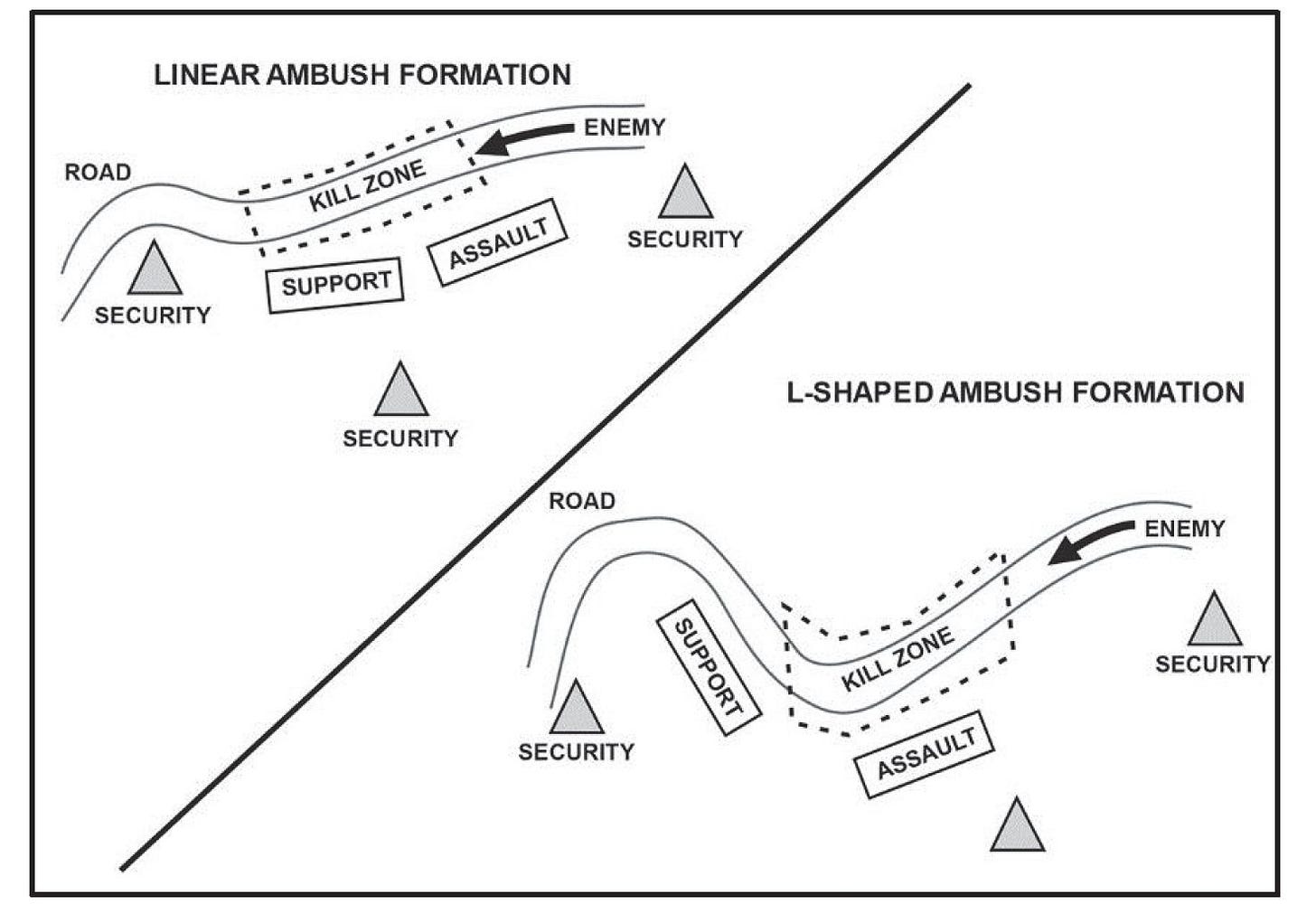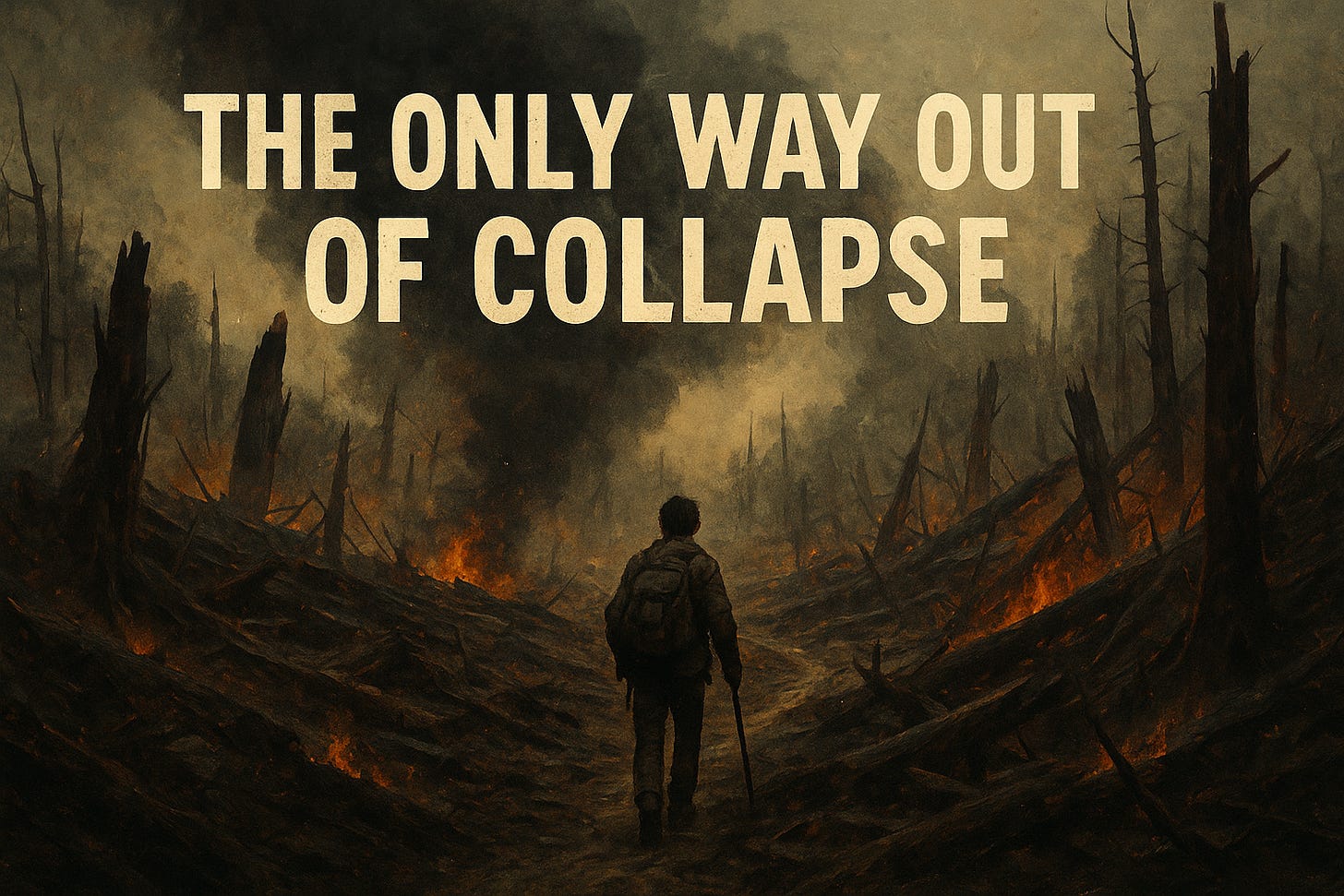The Only Way Out of Collapse
Collapse is an Ambush
Hey everyone—I've been off-grid this past week, getting quiet and grounded. But I'm back now, and I’ve got something powerful for you.
While diving into some material on combat tactics—specifically ambushes—I came across a principle that hit hard. Not just in a military sense, but as a lens for understanding collapse.
It clicked: there’s something here. Something visceral, strategic, and deeply relevant to the moment we’re living in.
This post is about that realization—and what it means for how we face what’s coming.
The Ambush
An ambush is a surprise attack launched from a concealed position against a moving or temporarily halted target. It’s a tactic rooted in asymmetry—one side knows what's coming, the other doesn't. The ambushers prepare the terrain, control the timing, and maximize damage before the target can respond.
Ambushes are not fair fights. They are traps, designed to exploit vulnerability, predictability, and delay.
In combat, two of the most common and deadly forms of ambush are the linear ambush and the L-shaped ambush. Each is designed to trap, disorient, and annihilate a target with maximum efficiency.
The Linear Ambush
This is set up along a road or a trail. The enemy waits in concealment parallel to your movement. When you enter the kill zone—usually marked by a terrain choke point like a bridge, a canyon, or dense foliage—they open fire.
In this scenario, retreat means running back into concentrated fire, and flanking is nearly impossible because the enemy controls the terrain. All movement is anticipated. You were allowed into the trap. The perimeter is sealed. You are not meant to get out.
The L-Shaped Ambush
Even more lethal. One leg of the “L” runs parallel to your path of travel. The other runs perpendicular at the far end. When the trap is sprung, you are raked by fire from two directions—the long arm tears through your ranks; the short arm blocks your escape.
It’s designed to make you freeze. To scatter. To despair. The moment you hesitate, it’s over.
The Only Way Out Is Through
In both cases, the doctrine is clear: if caught in the kill zone, your only hope is to fight forward, hard and fast, punching through the thinnest part of the line before the ambushers consolidate their kill.
This is the metaphor we carry into collapse.
We are inside the trap. The systems that sustained life—ecological, economic, cultural—are unraveling around us. And the tools of industrial civilization that caused the crisis are doubling down, accelerating the collapse.
There is no going back to “normal.” There is no stable ground to retreat to.
The only way out... is through.
But through what?
That’s what we need to name. Because collapse is not just a physical condition. It’s a wall of ideological, psychological, and systemic barriers. And until we understand what stands in our way—what we must go through—we’ll remain frozen in place, easy targets for the machine that is still very much functioning.
So let's map the enemy line in collapse—and what it takes to breach it.
Mapping the Enemy Line in Collapse
If this is an ambush, then we’re in the kill zone. That means we need clarity. Tactical awareness. A map—not of the terrain we wish existed, but of the real battlefield we’re standing on.
So let’s name the enemy line. Not metaphorically, but materially. What are the actual forces that keep us frozen, misdirected, demoralized, or turning on each other while the planet burns?
These are not just abstract “challenges.” They are engineered choke points, carefully designed to disorient, to weaken, to delay.
We identify five primary sectors of this enemy line:
1. Industrial Civilization
The Engine That Consumes the World
This is the backbone of the ambush—our way of life, built on extraction, expansion, and systemic violence. It is not broken. It is operating exactly as designed:
Forests are cut for profit.
Rivers are dammed for control.
Humans are disciplined into obedience for efficiency.
In short, civilization is unsustainable and irredeemable. No reforms will save it. No green tech will detoxify it. The structure itself is the disaster.
To punch through this barrier, we must disengage from the myth of progress, break from dependency, and learn to defend what still lives—not with hashtags, but with our bodies, our skills, and our refusal.
2. Psychological Pacification
The Manufactured Helplessness That Keeps Us Tame
This line runs deep—under your skin, inside your skull. It’s not just propaganda or distraction. It’s the engineered condition of passivity. Industrial society strips us of meaningful agency, then sells us simulation:
Work that doesn't matter.
Relationships mediated through screens.
Activism reduced to branding.
The "Power Process" explains it well: without real struggle, real autonomy, and real achievement, people collapse into depression, obsession, or surrogate goals. We chase likes instead of liberation. We debate language while ecosystems die.
The system doesn’t need your approval. It only needs your obedience—and your sedation.
To breach this, we reclaim our agency through real, tangible action: growing food, repairing, resisting, building—together, not alone.
3. False Hope and Magical Thinking
The Delusions That Keep Us Waiting
Every ambush needs a bait—and in collapse, it’s hope.
Not real, grounded hope. But the kind that delays action:
“Green growth” will save us.
“Smart cities” will fix it.
“Next election” is the turning point.
“AI will optimize everything.”
These aren’t solutions. They’re sedatives. Designed to redirect your fear into passivity, to keep you invested in a system that has already declared you disposable.
Hope that avoids sacrifice is not hope. It’s denial in costume.
To get through, we trade fantasies for courage. We stop waiting for better options and start doing the hard, human work of survival and resistance now.
4. The Shadow Within
The Deep Code of Domination
This is the most intimate line—and the most dangerous. It’s the part of us trained to dominate, to separate, to control:
The part that wants to be safe at the expense of others.
The part that clings to hierarchy even in collapse.
The part that consumes and exploits while preaching sustainability.
This culture teaches us to hate the wild, the feminine, the vulnerable—even ourselves. And until we confront that internalized violence, we’ll recreate the same systems in every post-collapse community we try to build.
To go through, we face this darkness. Not to be pure—but to be honest, and to act with integrity.
What “Through” Looks Like
Once you recognize the ambush, you stop pretending there’s an easy way out. You can’t run, you can’t hide. Your destiny is tied to your reaction. You stop playing by the enemy’s rules. You stop looking for rescue.
Going through collapse isn’t about survivalism. It’s about transformation.
But let’s be clear: this path is not clean. It’s not safe. It’s not linear. It’s a walk through fire—psychological, cultural, material.
Here’s what it looks like on the ground:
Grief That Doesn’t Flinch
You begin with honest mourning—for species lost, futures stolen, forests clearcut, oceans emptied.
Grief is not weakness. It’s the refusal to go numb. It is the price of remaining human in an inhuman system.
"If we did not hate ourselves, we could not allow our homes—and our bodies—to be poisoned." – Endgame
Skills That Ground You
Collapse is disintegration. “Through” means re-integration—of hands and soil, of community and trust, of body and meaning.
Grow food.
Repair tools.
Learn your watershed.
Share what you know.
Re-skill as resistance. Because the future will belong to those who remember how to live.
Structures That Don’t Obey
We don’t just need new tools—we need new systems:
Decentralized, not centralized.
Cooperative, not competitive.
Embedded in place, not floating on capital.
This is not utopia-building. It’s triage for society. It’s building lifeboats in a rising tide.
Resistance That Bites
Let’s not forget: collapse isn’t just entropy—it’s a war of elites against life.
And sometimes, the only moral response is to fight back.
Whether that’s:
Dismantling extractive infrastructure,
Exposing corporate greenwashing, or
Protecting land and water by any means necessary—
The point is: through doesn’t mean passive endurance. It means defiance.
Community That Endures
No one breaches the enemy line alone. The myth of the rugged individual is just another weapon.
Build networks. Build trust. Share grief, food, knowledge, shelter.
Mutual aid is not charity—it’s survival.
What Do We Choose Now?
We’re not waiting for collapse. We’re already in it. The ambush has sprung.
The terrain has been shaped against us. The economy is devouring the earth. The ideology in our heads tells us to submit. The systems of power are doubling down. And the path of least resistance leads straight to annihilation.
But there’s still a choice.
We don’t get to choose the ambush. We do get to choose our response.
So what will it be?
Do we freeze in place—waiting for the next political savior, the next distraction, the next soothing lie?
Do we run—toward false solutions, greenwashed promises, and empty spiritualism?
Or do we turn, face the line, and punch through?
Because on the other side of that line is not paradise. It’s not safety. But it’s reality—honest, difficult, wild, and alive.
It’s a way of living rooted in soil, in reciprocity, in resistance.
And if we don’t go through now—if we keep stalling, consuming, postponing—the trap only tightens. The violence gets worse. The grief deepens. The collapse becomes catastrophe.
So we ask again:
What stands in our way? And who do we become when we breach the line?
The only way out of collapse...
is through.





Hands down ~ ONE of the BEST THINGS I’VE EVER READ about our global/societal/personal dilemma!! 🌟🌟🌟🌟
Thank you thank you for articulating things I have long been aware of and thinking about, you just took me to a whole new level of clarity.
Punching through. What a wonderful way of putting it. We need to make IRL, local friends, as many as possible, focused on growing food as well as all the other skills that makes life (and community) possible under collapse conditions, because those conditions are coming over the horizon. Setting up a system that enables people to work together on common goals they all agreed to support. It’s a lot of work. So yeah. Punching through is an apt analogy.
Like politics, it’s all local. Start with notices at the local library. Local. Physical. Online has had its chance and failed miserably.